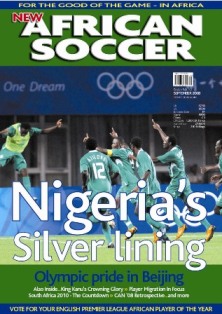|
Black People Don’t Play Soccer? Unlocking American Soccer’s Secret Weapon. Robert Woodward
Despite the migration of world football's superstars to the NASL in the 70s, hosting the World Cup in '94 and now Beckham earning his mega $'s on the other side fo the Alantic, America silll remains largely blind to the beautiful game. Football stateside has just never quite arrived. It's always struggled to match the popularity of America's homegrown sports - baseballl, basketball and American football. In his soon to be published book Robert Woodward asks why Black America aren't footballphiles and dreams of a future where African-Americans help the US to achieve its football potential. Here Woodward gives NAS readers a sneak peak at the introduction of Black People Don't Play Soccer?
I have a dream.
I’m standing in Maracana Stadium in Rio de Janeiro, Brazil, the year 2014 with a band of close friends and coaches from the States. Surrounding us are 95,000 screaming soccer enthusiasts eagerly anticipating the United States’ first World Cup Final appearance against the host nation, five-time World Cup winners Brazil.
The stadium pulsates in a sea of yellow and blue – the colors of Brazil – punctuated by tiny bands of the red, white and blue of American fans. The throbbing, rhythmic beat of samba drums surrounds us as Brazilian fans sing passionately, trying to weave a magic spell calling for victory for their heroes.
Brazilian fans believe God is a Brazilian fan and there is no option but winning. Our Brazilian hosts laugh and sing with us in the pubs but politely remind us the suggestion Brazil could lose to the U. S. is absurdly ridiculous and completely unacceptable.
They say Americans don’t deserve to win the Cup. To them, we can’t understand soccer, lacking the passion and love for the game that only a Brazilian could understand. Allowing the arrogant Americans to win the World Cup would be too much for Brazil to bear. The odds makers agree, favoring Brazil to win 3-0, fueling a sense of resignation that lingers over many of the American supporters. A few privately admit pessimistically the best they hope for is avoiding embarrassment. For them, losing only 1-0 or in penalty kicks to Brazil would constitute a moral victory of epic proportions. No reasonable people truly believe they could beat Brazil, the heart and soul of soccer.
Brazil starts the game brilliantly, passing the ball around the first two minutes without the U. S. getting a single touch of the ball. The crowd roars its approval at Brazil’s superior technical skills. Their confidence borders on arrogance and they start playing to the crowd, more interested in entertaining the fans with little tricks than scoring. Tension continues to build as the Americans hold off wave after wave of Brazilian attackers. The pro-Brazilian crowd chants grow louder with increased tempo and volume anticipating the critical first goal.
The Americans prove to be a tougher foe than expected. Not only do they handle Brazil’s offense, they put pressure on a Brazilian defense more interested in pushing up to help the offense. The underdog Americans defend in numbers and counterattack dangerously with
style, confidence and the belief they can produce a historic win.
It shocks most observers that the United States made it to the Finals. In the years preceding the World Cup, the U. S. continued its development as a soccer nation. David Beckham took Major League Soccer to new heights, bringing a new light on soccer. Other players from Africa, South America, Europe and Asia found the States to be a choice destination for veterans with marketability and promising youngsters looking to make their marks. League owners made more
good decisions than bad and ESPN gradually made a total commitment to treat soccer as a major sport.
Suddenly, soccer keeps some of the superior athletes it once lost to basketball and football. Increasing numbers of Hispanic and black players find their way into youth soccer leagues around America, dramatically improving the talent pool. Print media and the generation of sportscasters who grew up in the age of Pete Rozelle and the NFL’s rise to prominence fade into the background. As the daily newspaper fade into oblivion, American media lessens its overt hostility toward soccer.
The U. S. Soccer Federation’s long-standing commitment to improving playing and coaching standards pays dividends with impressive showings against top teams. Americans become more than just average defensive-minded players; many become celebrities abroad and become familiar to the average American sports fan. Still heading into the 2014 World Cup, few experts predict the U. S. will make it past the quarterfinals.
The U. S. wins its group competition, defeating Poland, Japan and Colombia in impressive fashion. In the round of 16, the U. S. shows the world it has the skill and coaching to be a world power with a 3-1 thrashing of Holland. The humiliation of a proud Argentina side 2-0 in the quarterfinals makes the world sit up and take notice. The impact of the victory back home in the USA is amazing. For the first time, soccer is on the lips of all Americans, not just its long-suffering soccer fans. The knowledgeable soccer fan suddenly goes from being an oddity at the company water cooler to a source of wisdom for those suddenly swept up in Cup fever.
Earlier during the Cup, the few soccer bashers who remained reared their ugly heads, spewing their usual skepticism and cynical prose about how soccer would never make it in America. The victory over Argentina silenced those voices under the fanfare and patriotic fervor inspired by an American team that became instant heroes.
One by one, the talking heads of the sports world feverishly study their notes and climb aboard the bandwagon. Magically soccer is everywhere; you can’t turn on the television without seeing expansive soccer highlights, soccer commercials, profiles of players and former players and coaches analyzing players and strategies on primetime TV.
When the U. S. wins its semifinal match against France, interest explodes as ordinary Americans watch in record numbers and spontaneous parties break out in the streets and town squares of cities across the country. People start planning vacation days to watch the games and some simply call in sick or quit their jobs. The hometowns of the players declare holidays and set up huge public viewing parties. America finally joins the rest of the world in the holiday that is the World Cup.
After weathering the initial Brazilian onslaught, the U. S. starts to dominate play. The Americans match the skill of the Brazilians and steal the advantage, using their superior size and speed. The pro-Brazilian crowd grows increasingly restless with each passing moment. The crowd’s singing grows ragged and inconsistent and most Brazilian fans stop dancing and watch nervously. In the thirty-fourth minute a brilliant one-two combination down the left sideline springs an American attacker down the wing. His cross from the sideline seems destined to sail harmlessly across the goal. Instead, a 6’5” forward skies over a pair of Brazilian defenders powering home a thunderous header past the goalkeeper.
Back home, the housing project where the unlikely hero learned to play in an inner city program erupts in celebration, as do the ten thousand Americans who managed to get nto the stadium. America, the nation that couldn’t care less about soccer, is caught in the grip of the impossible dream. For the first time, Americans feel what everyone else in the world already knows. Soccer is as compelling as any other sport when you have an emotional stake in its outcome. Millions watch breathlessly transfixed in a way they never before imagined. The Brazilians become increasingly frustrated at the stifling U. S. defense and resort to diving at every possible opportunity. Tim Howard, the elder statesman of U. S. soccer, is a rock in goal turning away everything sent his way.
The result becomes a formality five minutes from the end with a U. S. goal that ranks among the ages. The scorer is another player who learned his craft playing on asphalt courts and in the streets and snakes his way through the Brazilian defense. Receiving a ball forty yards from goal, he twists, turns and cuts through a gap in the defense. He dribbles through Brazil’s midfield, then, with a devastating crossover, dribble, splits the final pair of defenders and gleefully rolls the ball through the keeper’s legs and into the goal. Pointing up into the sky, he races to the corner to dance in celebration in front of the delirious U. S. fans.
It was 2-0 U. S. over Brazil and the party starts in earnest. As the clock winds down the final minutes, the Americans stroke the ball around the field playing keep away from the Brazilians. The Brazilian players start arguing with each other and begin to lose their cool. The neutral spectators and American fans chant “Ole, Ole, Ole, Ole,” while Brazilian fans in the stadium and across the entire nation sit in stunned silence. Tears of joy stream down my face as the referee blows the final whistle. The U. S. fans, players and coaches watch in awe as the United States raises the World Cup trophy and become World Champions of the world’s most popular game.
It never hurts to dream. What makes my dream unique is only because I am a middle-aged African-American who played soccer in the Seventies. That statistical anomaly has been a source of puzzlement for friends, family and acquaintances throughout the years. Soccer became the game of choice for me as a participant as well as a spectator through a series of coincidences and good fortune.
For all the game has given me, it is a labor of love to become part of the solution to help soccer “make it.” Long the “other” sport, the foreign sport, misunderstood and misrepresented, soccer has enormous untapped potential. The rich if undiscovered history of soccer and the men of color is full of stories about individuals who excelled on and off the field. Black America has all but ignored the game in its museums and history books.
Consequently, African-Americans never embraced soccer, as do their brothers around the world. The topic of African-American athletes and sports fans not being involved in soccer pops up from time to time but never has there been a detailed study or analysis. Far from being a complete answer to a complicated issue, my hope is that this book will stimulate people into thought and action that will lead to benefiting soccer and the black athlete.
|




